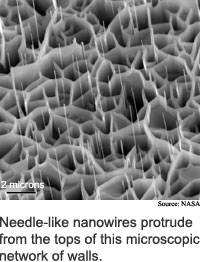
Tiny walls sprout nanowires
One of the promises of nanotechnology is the
ability to make very precise materials by growing them molecule-by-molecule.
Researchers from San Jose State University have found a way to coax
tiny, three-dimensional structures to form on graphite, which conducts electrical
current, and sapphire, which blocks electricity.
The method allowed the researchers to construct a honeycomb-like
structure of walls with a wire rising from each junction between walls.
The nanowalls and nanowires are about 80 nanometers thick, which is about
eight times narrower than the diameter of an E. coli bacterium.
The structures could eventually be used in devices that convert
and store energy and in data storage devices, according to the researchers.
Key to the researchers' method is adding a thin film of gold at
key places on the graphite or sapphire substrate that chemically spurs the
growth process of the tiny structures. The researchers controlled the process
by adjusting the spacing and thickness of the gold catalyst.
The method could be used in practical applications in two to five
years, according to the researchers. The work appeared in the May 23, 2003
issue of Science.
DNA makes nano barcode
Study reveals Net's parts
Recommenders can skew results
Light pipes track motion
News briefs:
Material helps bits beat heat
Process puts nanotubes in place
Printing method makes biochips
Tiny T splits light
Tiny walls sprout nanowires
Big sites hoard links

Research Watch blog
View from the High Ground Q&A
How It Works
RSS Feeds:
News
Ad links:
Buy an ad link
Ad links: Clear History
Buy an ad link
|
TRN
Newswire and Headline Feeds for Web sites
|
© Copyright Technology Research News, LLC 2000-2010. All rights reserved.